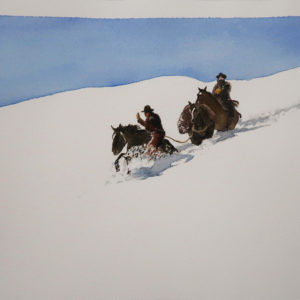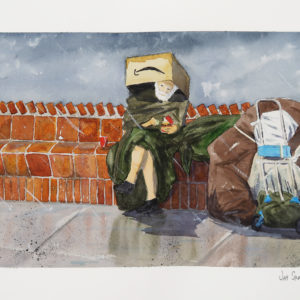Description
“We Hold These Truths”
Jay Samit interviewed by Tanya Hayes Lee
Jay Samit, innovator, artist, author, and internationally-acclaimed public speaker, usually spends a lot of time on airplanes and in hotel rooms, but the pandemic has restricted him to his home for more than 200 days, and counting. He has used these months to deliberate on the cultural meanings and implications of our current global crisis and to paint a series of delicate, detailed watercolors that reflect his thoughts. His solo show, America Disrupted, opens at the Richard Taittinger Gallery in New York on September 30th. https://richardtaittinger.com/exhibition/america-disrupted/
The period of Jay’s self-sequestration was a trying one for our Nation. Protests, violence, suffering and death. While the collection of watercolors in Samit’s show touch on a range of these issues, for me the emotional cornerstone for the show is the mirror he holds up to America in “We Hold These Truths.”
Painted in vibrant realism, in this painting Samit considers the violence that has permeated, and to some degree defined, the history of the United States since the very beginning. The painting of this desk blotter commonly found in hotel rooms looks at first glance as if it is innocently covered with the detritus of any business trip. “Then you start realizing it is a map of the U.S., both figuratively and literally,” Samit explains.
The issues surrounding the Black Lives Matter movement gave Samit the idea for the painting. “Up until World War II, they would make postcards of lynchings of African Americans. People would send them back home as a way of saying, ‘I was there.’ I couldn’t paint something like that,” he says, but the postcards on the blotter reference that practice and transcend it.
“The Native American (upper left), Iron Hall, was a survivor of Wounded Knee. That was not a battle, it was a slaughter of women and children. In the center is a postcard from Minneapolis where an officer put his full weight on George Floyd’s neck and killed him in May. Dealey Plaza—JFK was assassinated there. And then the Lorraine Motel, you see the key to it at the bottom. Martin Luther King Jr. stayed in room 306, and he was assassinated there. The postcard at the very top was from the opening of the Dakota, one of the grandest buildings ever built in New York at that time. It was John Lennon’s home, the place where he was killed,” explains Samit.
Samit says authenticity was critical to him as he created this work. “I carefully researched every detail from the 80s french fry packaging used at the San Ysidro McDonald’s to Dr. Martin Luther King’s room key at the Lorraine Motel, and the price Emmett Till paid for bubble gum on the day he was murdered.”
Four presidential assassinations are commemorated here — Garfield and McKinley in stamps, the postcard for JFK, and the copper penny for Lincoln. As are other murders. The discarded cigarette in the ashtray from the Audubon Ballroom, where Malcolm X was assassinated, the MILK stamp, for Harvey Milk, the gay right activist assassinated in San Francisco, a matchbook from Stonewall, the bar in New York City where police would routinely arrest gays, and the matches from the Ambassador Hotel in LA where Robert Kennedy was assassinated.
“The saddest part of researching this piece was confronting the staggering amount of violence we have all become decensitized to,” Samit said, “chosing which ones to memorialize was painful.”
“The envelope right underneath the Dakota postcard is addressed to a Reverend Nagatoni, a Japanese-American, at Manzanar, where we locked up 120,000 Japanese in World War II, an act that was unconstitutional. What’s interesting is the date on the envelope, which was after the war, and they still hadn’t released him,” says Samit.
“In the bottom left hand corner is a receipt from Bryant’s Grocery down in Money, Mississippi. That’s where a young man from the north named Emmett Till went in to buy one piece of bubble gum and was accused falsely of having whistled or catcalled to a white woman. Emmett Till was savagely beaten and murdered. But his mother was brave enough to allow the picture of his corpse to be put in the papers around the country and that really was key in the civil rights movement,” he continues.
The painting references not only individuals but events that impacted tens of people and our national consciousness. In the upper right hand corner is Ferguson, “where the whole town made its money by arresting minorities,” and Michael Brown was killed by police in 2014, sparking riots and protests. The pencil on the right is from Sandy Hook, where 20 children and six adults were murdered in the largest school shooting in the country. Another school shooting is commemorated by the VT logo, for Virginia Tech, site the largest university mass shooting, in 2007.
“The French fries on the left are shown in 1980s packaging for McDonald’s to represent the 1984 San Ysidro massacre. McDonald’s didn’t want to become a shrine and 24 hours later they bulldozed the restaurant and removed it from the face of the earth. And the Pulse night club in Florida was the site of the largest night club killing,” Samit says. In the bottom right corner is the Route 91 Harvest Festival. That was where a sniper sat in a Las Vegas hotel room and killed 60 people and wounded more than 400.”
The envelope of America bears a Little Rock, Arkansas, cancellation. “That’s the day that we needed the National Guard to take a five-year-old girl safely to school,” says Samit.
When he was researching the project Samit came across Sambo’s restaurant where you could get a wooden nickel for a free cup of coffee. “When did Sambo’s go out of business?” he asks. “June. Of this year.”
“So when you put this all together, this is who we are,” says Samit.
The Statue of Liberty in the middle is the hope that we all yearn for. I did another painting of just looking up the Statue of Liberty and you can’t see her face. The torch is there, Liberty is there, our ideals are there, but they always just seem not to be realized,” he says.
The “please do not disturb” sign is one that any hotel room would have and for Samit it represents the fervent wish of the oppressed people and groups in this country. “All that any of these groups, all that any of these people could ask for, is to let them live their lives—please do not disturb.”
And sitting off to the side, unopened is Gideon’s Bible. The title of the painting comes from one of our most important documents—the Declaration of Independence, says Samit. “‘We hold these truths to be self-evident, that all men are created equal, that they are endowed by their Creator with certain unalienable Rights, that among these are Life, Liberty and the pursuit of Happiness.’ These are the cornerstones that I believe in, that all of us espouse, and yet we’re divergent from them.”
Samit hopes that making our grim history explicit in a painting that on the surface seems to depict a scene so tranquilly commonplace will lead people to reflect on the kind of America we desire. “Each totem,” he says, “bears witness to our collective history as we struggle to accept the truth and move forward together as a nation.”






Reviews
There are no reviews yet.